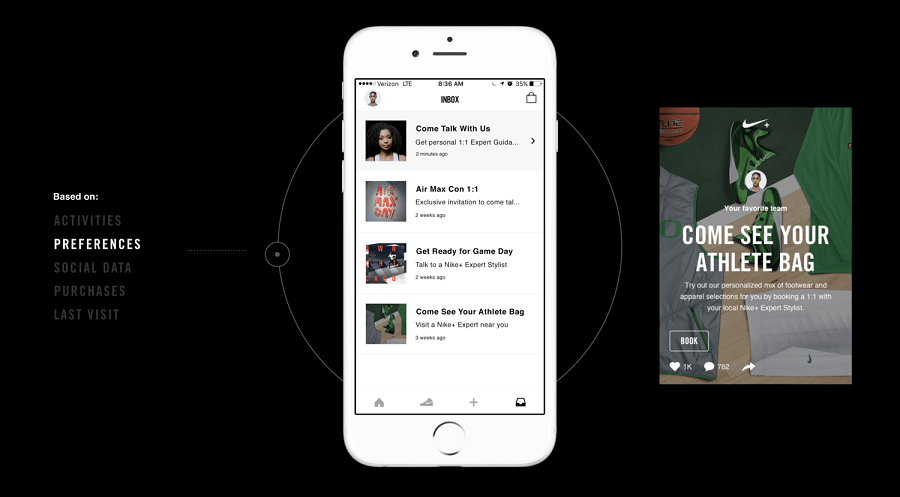By Aleena Mazhar
For brands doing business in Canada today, the need for personalization is greater than ever before. Consumers are exposed to between 4,000 – 10,000 ads in the span of a day, and as a brand, there is a need to stand out. One of the most impactful ways to be noticed is to provide consumers with added value that’s specific to their lives. 90 per cent of consumers find personalized experiences appealing and 80% believe they are likely to purchase from a brand that offers these curated experiences.
There are varying degrees and moments to personalization within customer experience (CX) strategy, and brands that do this well build an omnichannel approach that utilizes their customer data to add value in many different ways. They are able to overlay their digital experience with their physical experience to continuously learn about their customers. These data points can then help them build experiences that connect personally with their consumer in a meaningful way and deliver better CX – 86% of consumers say this is their main driver, with more and more companies investing the necessary budget to do so.

The leader in CX personalization is Amazon. They have made it easy, convenient and practically automated as it relates to product purchasing and fulfillment. They build recommendations from your order data and frequency that is personal to your unique shopping habits. They’ve also played with the physical manifestation of their brand with Amazon Go. This “grab and go” brick-and-mortar retail experience is expected to grow with Amazon opening a 10,400 sq. foot retail store in Seattle. Their physical cashless experience is still experienced within their app, continuing to personalize the shopping journey and get to know more about their customers through AI and facial recognition that they have installed within the store. The app helps trigger purchases in-store, with a consumers’ behaviour being tracked every step of the way.
Another great example of a leader in personalization is Nike, who aims to completely understand the needs of every athlete – and believes that if you have a body, you are an athlete. Nike goes deep with its customers to find meaningful and personalized ways to connect.
Their first step in personalization is realizing one size doesn’t fit all. Nike’s apps like Nike Run Club and Nike Training Club all provide different services for different people that buy their product. They know that a runner has different needs than a CrossFit enthusiast, so they create a community specific to each niche.

The introduction of Nike+, a membership program that provides customers with exclusive access, personalized experiences, one-of-a-kind products, and advice from real athletes and influencers, has taken Nike’s brand engagement to the next level. This type of deep relationship building between the brand and its loyal fans allows Nike to create micro experiences that are member-only, frequent, and personal. They continue to exemplify this through local run clubs, exclusive meet and greets, and community first product launches.
While Amazon and Nike are two completely different brands, they have both personalized the customer experience. For brands that are looking to be more personal, they should consider the following tactics:
Personalization should be omnichannel by looking at your customer experience journey in a holistic manner. A brand must create connections between both your digital experience, and how your brand is experienced in the physical world through experiential and retail channels. Experiential marketing within the physical environment through events, brand experiences, and one-of-a-kind moments help build brand loyalty in a meaningful way.
Personalization should consistently evolve, measured through rich data at all points of the customer experience. Think through the data within each part of the experience and leverage it to add value to the customer. These data points should drive sales through retargeting customers with content, products, and experiences that are unique and relevant to them. It will also help brands learn more about their consumer.
Personalization should be relevant. The value a brand adds for its customer must be consistent and relevant in order for it to be unforgettable, including the value added touchpoint with custom labels on products. Brands that are only consistent with a lack of relevance become forgettable, while brands that are relevant only once in a while don’t stand out. Creating a two-way dialogue with consumers that is always timely will be noticed.
Personalization is one of the key drivers of purchase consideration for brands – with 40% of people likely to spend more when their shopping experience is highly personal, and 75% of people more likely to purchase from a company that knows their name and purchase history. If done well, personalization will create brand loyalty, repeat purchases, and make your brand an integral part of your consumer’s life.

In the past eleven years, Aleena Mazhar has grown up within the ever-evolving live experience business. Her focus is to create experience-led integrated campaigns for brands that are looking to get noticed. Working with top tier clients on award winning work, Aleena works with a strong team of creative problem solvers to build moments of human connection that drive her clients’ businesses forward. Her passion for coaching a team, and solving big complex creative problems drives her continued excitement for the marketing industry.



